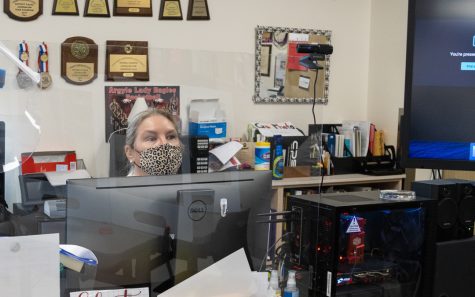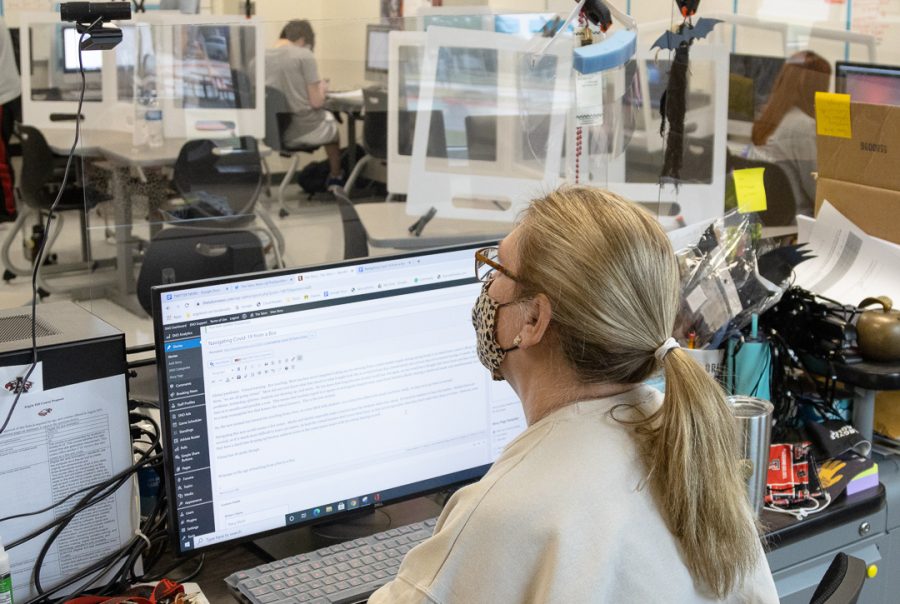©The Talon News | Nicholas West
Teacher Stacy Short looks out at her face to face class as her virtual learners view through the lens of the camera. (The Talon News | Nicholas West)
Teaching with Covid-19 from a Box
Teaching in a New Dimension with both Virtual & Face to Face Learners
October 28, 2020
Global pandemic. Virtual learning. Box teaching.
Most teachers never imagined waking up one morning from a much-needed respite during spring break to an email from a school official telling them, “we are all going virtual.” Most did not even know what that meant or what it might look like as normal 8 hour days turned slowly into 16 hour days of a constant barrage of emails, digital problems, technology glitches, students not showing up, and worry. No one knew how long this new normal would last, but again, no one would have thought that those hours and days would turn into months and possibly a year. This means that teachers report to their room, teach from behind a shield, wear a shield and mask, and simultaneously teach to their computer that houses the virtual learners.
This is the new normal.

Navigating this new world creates a few issues. In the beginning, the learning curve, even for someone relatively apt at technology, seemed insurmountable. At one point, there were at least 13 new or changed platforms for learning that had to be navigated, then taught to students just to start the learning process. Patience, empathy, and understanding are necessary tools for the day.
Social distancing and masking have become staples. Reminders, over and over again, to “mask up”, “cover your nose” and “no hugs” continue to be part of these changes. Masks and shields make it hard to hear students when they speak, so we repeat, repeat, repeat, then do it again. It’s also hard for students to hear the teacher. Students’ faces are covered (mostly), so it is much more difficult to learn 150 names. At least the virtual learners don’t cover their faces, so they are recognizable when they don’t mute their faces or voices. However, even they have a hard time keeping up because ambient noise in the room causes issues with the virtual hearing as well.
Virtual learning has its perks though. Students at home, while they still have the stress of classwork, have a few more breaks in the day, and can wear comfy clothing and learn from their couch, or bed, or in the car for some. From a teacher standpoint, I can say that for the first time in thirty years of education, the face to face students actually seem thankful for being in the classroom. Every day, every class period, at least one student says thank you. It’s such a small act of kindness that goes so far in every good way. It almost makes it all worth it.
And then there is the stress, from the box, the feeling of isolation, the communication (some too much and some too little), the unknowing, the fear. As students disappear from classes, as teachers disappear, or emails are sent about another case of COVID-19, or another quarantine, it emulates all the craziness of dystopia that people fear. It is human nature to fear the unknown. As humans, we all handle this fear differently. For many, putting faith in a higher power helps, for others, getting to know the science helps. Many simply walk around in fear. For some, noncompliance is simply a way to gain power, which falsely helps some to cope with this new reality. Teachers will keep on teaching, students will continue learning, and the world will continue to change. There is no answer right now. We are all simply trying to survive this new world of change and fear.
Welcome to the age of teaching from a box to a box.
